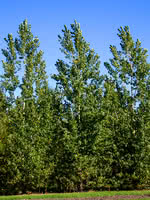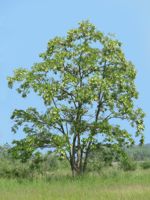Mon-Fri 9am - 5pm Mountain time
Prairie Sky Poplar vs Black Locust
Populus x canadensis Prairie Sky
Robinia pseudoacacia
Prairie Sky Poplar is a fast-growing columnar hybrid poplar developed at Agriculture and Agri-food Canada's Morden Research Station. It is adaptable to many soil conditions and seems to do best in the southern-most parts of the prairies.
Good as a shade or shelterbelt tree, it is often used in buffer zones as a visual screen or hedge. Ideal for lining properties, roads, etc.
Black Locust is an attractive tree. Its distinctive leaves are made of about a dozen bright green leaflets. It also notable for its fragrant white flowers, which smell of citrus.
Black Locust can grow in many situations, but prefers dry areas with lots of sun. It is robust and is an excellent choice for establishing shade in dry, open areas.
Important note: Much of the Black Locust is toxic to humans and livestock, including seeds, bark, and leaves.

